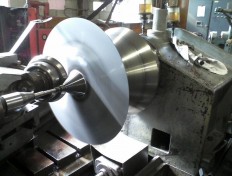Metal Spinning Process
The metal spinning process is a forming process used to produce circular hollow metal parts. To produce a part, a metal disc is revolved on a specialized lathe, while held against a spinning block, or mandrel, with a follower. As the disc rotates, spinning tools or rollers are used to force the disc onto the spinning block or mandrel. The material thickness of the finished part can be closely controlled, with reduction of 10% to 50%. Metal spinning is a low fixed cost, high variable cost process. Tooling and setup is relatively inexpensive, while production time will run from 2 to 20 minutes.
Metal Spinning is used for short runs and for material that is more pliable such as O tempered (dead soft) aluminum and lighter gage steel and stainless.
Multi-Pass CNC Spinning can be used for short runs of more difficult to spin materials and high production quantity parts where consistency is of paramount importance.
Shear Form Spinning or Flow Turning achieve a deliberate and controlled reduction in blank thickness versus the limited reduction in multi-pass spinning. Church Metal uses shear forming to produce conical shapes and pre-forms. An advantage of shear forming in excellent repeatability and high surface finishes can be achieved.

Tooling for metal spinning consists of a spinning block or mandrel, a follower, a roller and a trim block. The spinning mandrel is generally shaped like the part to be produced. The madrel can be made from wood, synthetics, HR steel or higher alloys depending on the material of the part and the longevity of the job. Followers and rollers can often be used interchangeably on different jobs. Trim blocks may not be required. Occasionally, multiple spinning tools may be required.
